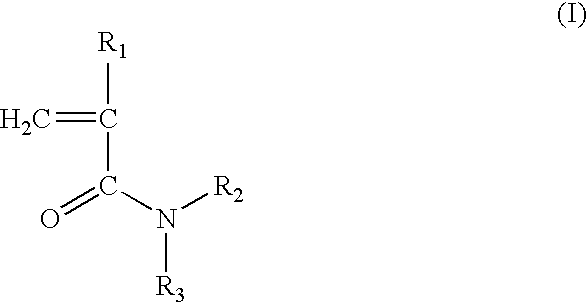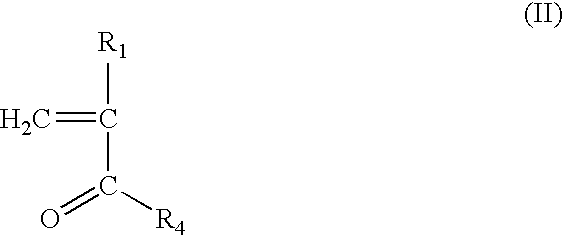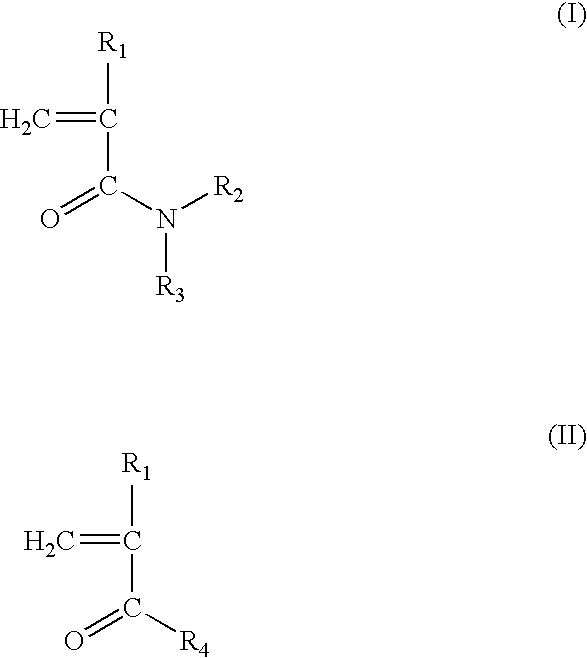CMP polishing compound and polishing method
a technology of polishing compound and polishing method, which is applied in the direction of lapping machines, inorganic non-surface-active detergent compositions, lapping machines, etc., can solve the problems of insufficient polishing rate, low polishing rate against practical use, and unfavorable polishing of concave regions therein
- Summary
- Abstract
- Description
- Claims
- Application Information
AI Technical Summary
Benefits of technology
Problems solved by technology
Method used
Image
Examples
synthesis example 1
[0052]Into a 2-L flask were charged 400 parts of deionized water, and the temperature of the water was raised to 90° C. while the water was stirred in the atmosphere of nitrogen gas. Thereafter, a substance wherein 1 part of a polymerization initiator (trade name: “V-085”, manufactured by Wako Pure Chemical Industries, Ltd.) was dissolved in 100 parts of N,N-dimethylacrylamide was poured into the flask over 1 hour. Thereafter, the temperature of the solution was kept at 90° C. for 5 hours, and then the solution was cooled to room temperature. The resultant was taken out, so that a water-soluble polymer solution was obtained.
synthesis example 2
[0053]Under the same conditions as in Synthesis Example 1, 95 parts of acryloylmorpholine and 5 parts of acrylic acid were polymerized. The resultant was cooled to room temperature, and adjusted into a pH of 7.8 with ammonia water. In this way, a water-soluble polymer solution was obtained.
synthesis example 3
[0054]Under the same conditions as in Synthesis Example 1, 95 parts of N-isopropylacrylamide and 5 parts of acrylic acid were polymerized. The resultant was cooled to room temperature, and adjusted into a pH of 7.5 with ammonia water. In this way, a water-soluble polymer solution was obtained.
[Production of Polishing Slurry]
Example 1
[0055]One kilogram of the cerium oxide particles prepared as described above, 23 g of a (40% by weight) solution of an ammonium salt of polyacrylic acid in water, and 8977 g of deionized water were mixed. While the solution was stirred, the solution was subjected to ultrasonic dispersion for 10 minutes. The resultant slurry was filtrated with a 1-μm filter, and further deionized water was added thereto so as to yield a 5% by weight cerium oxide slurry.
[0056]The pH of the slurry was 8.3. In order to measure the slurry particles with a laser diffraction type particle size distribution meter, the slurry was diluted into an appropri...
PUM
| Property | Measurement | Unit |
|---|---|---|
| crystallite diameter | aaaaa | aaaaa |
| crystallite diameter | aaaaa | aaaaa |
| temperature | aaaaa | aaaaa |
Abstract
Description
Claims
Application Information
 Login to View More
Login to View More - R&D
- Intellectual Property
- Life Sciences
- Materials
- Tech Scout
- Unparalleled Data Quality
- Higher Quality Content
- 60% Fewer Hallucinations
Browse by: Latest US Patents, China's latest patents, Technical Efficacy Thesaurus, Application Domain, Technology Topic, Popular Technical Reports.
© 2025 PatSnap. All rights reserved.Legal|Privacy policy|Modern Slavery Act Transparency Statement|Sitemap|About US| Contact US: help@patsnap.com



